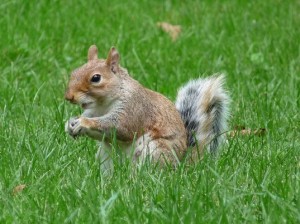Alum Pens an American History–of Squirrels
-
-
slice.mit.edu
Filed Under
Recommended
But as Etienne Benson PhD '08 points out in a recent Journal of American History issue, squirrels came to cities by invitation.
The eastern gray squirrel, which Benson focuses on, was plucked from his native forest habitat as landscape architects designed the country’s greatest city parks in the late 19th century. Because industrialization had stripped away their daily encounters with beasts of burden, Americans found spotting squirrels in city parks a pleasant substitute.
We can learn a lot from our history with squirrels, says Benson, an assistant professor in the department of history and sociology of science at the University of Pennsylvania.
“The way urban Americans thought about squirrels [in the 19th c.] was definitely condescending and rooted in a hierarchical understanding of nature and society,” he told Popular Science. At first, squirrels were “a novel and much-commented-upon feature of the American urban scene,” first introduced in Philadelphia and Boston and then in other major parks around the country.
We all know how that history changed.
Squirrels soon became known for spreading diseases and parasites. In big cities, they occupied dumpsters, harassed tourists, and chewed electric lines. “No feeding wildlife” signs popped up from Central Park to Yellowstone. As cities developed more holistic attitudes towards ecology, Benson notes, squirrels found themselves in trouble.
“The killing of squirrels by hawks, while perhaps distasteful, was natural and a sign of the city's ecological revival,” writes Benson.
As for squirrels in Cambridge, Benson cites Mt. Auburn Cemetery as the first area park where they were introduced. They migrated eastward and were first observed in Harvard Square in 1902. The only squirrels native to MIT's campus, it turns out, might be robotic ones or those employed for various tasks on Scratch.
Benson's interests go beyond squirrels. He studies the way humans interact with nature around the world, particularly in terms of technology. In a 2008 essay, Benson expressed concern for the overexposure many species get in the wild from scientific surveillance. His 2010 book, Wired Wilderness: Technologies of Tracking and the Making of Modern Wildlife, expands that argument.
Benson’s interest in squirrels predates MIT, but in studying for a PhD at SHASS, he found a welcoming place for his curiosity.
“My PhD advisor at MIT, Harriet Ritvo, is one of the people who have made it possible to take human-animal relationships seriously as a historical topic,” says Benson. “Without her model and support I don't think I would have had the courage to take on the topic or to submit the paper to a journal like this.”








